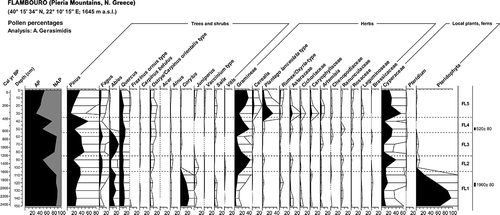Abstract
Site details
The Pieria Mountains extend in a north-northeast to south-southwest direction with two main exposures, eastwards to the Aegean Sea and westwards to mainland Greece. Their highest peak, Flambouro, rises to 2190 m a.s.l. The small mire lies about 2.5 km north-west of the Flambouro peak (22°10′15″ E, 40°15′34″ N; 1645 m a.s.l.; size ca 0.1 ha) just below the timberline of Pinus sylvestris L. In the same mire a Tauber pollen trap has been placed since 1996 to monitor the annual pollen deposition (Gerasimidis et al., Citation2006). Moreover, a high-resolution pollen analysis was performed on the upper part of the mire sediment (Gerasimidis et al., Citation2008).
The eastern side of the mountain is exposed to winds carrying moisture from the Aegean Sea, while the western side of the mountain in the lee of these winds receives less precipitation. This difference in moisture availability is expressed in the actual vegetation with beech forest on the eastern slopes and dry Pinus, especially P. sylvestris, dominated forests on western side. The climate is characterised as humid continental, with short warm summers (Dfb type according to Köppen). In the Pieria Mountains siliceous metamorphic rocks, mainly in the form of gneiss, dominate the substrate (Mountrakis, Citation1985; Reif & Löblich-Ille, Citation1999; Gerasimidis et al., Citation2006).
Sediment description
The core of 150 cm was extracted in 1980.
-
0–117 cm: Cyperaceae peat
-
117–133 cm: Cyperaceae peat with clay
-
133–150 cm: Dy with clay and sand
Dating
The radiocarbon dating was carried out by the Institut für Radiumforschung und Kernphysik der Österreichischen Akademie der Wissenschaften in Vienna, Austria. Results are:
-
48–52 cm: 520 + 80 BP (VRI - 749)
-
120–125 cm: 1960 + 80 BP (VRI - 750)
Interpretation
The pollen sum (100%) includes all pollen grains except those of aquatic plants, ferns, and Cyperaceae, the latter dominate the local vegetation.
The diagram () covers a period of 2500 years, during which Pinus remains the major component of the forest vegetation covering the west side of Pieria and forming, at higher altitudes, the climax association Pinetum sylvestris. Based on the trend of the major tree pollen curves, five zones can be defined:
Figure 1. Pollen percentage diagram of Flambouro (Pieria Mountains, northern Greece; exaggeration factor: 5).

-
FL 1 (150–105 cm): Besides Pinus, the presence of Abies is significant while Fagus shows low pollen values. The high pollen values and the presence of Corylus are noticeable only in this zone.
-
FL 2 (105–85 cm): Coniferous forests suffer an intense reduction. On the contrary Fagus recovers with regard to the previous zone. At the same time, the pollen values of Ostrya-Carpinus orientalis-type, which originates from the low-altitude vegetation, increase gradually and reach their peak in the middle of the upper zone (FL 5) of the diagram.
-
FL 3 (85–55 cm): Pinus and Abies increase strongly in relation to the previous zone. Abies scores its highest pollen values, although by the end of this zone suffers an intense reduction and in the following pollen zones is almost absent. Fagus on the contrary shows an increase in its pollen values though these are lower than Abies.
-
FL 4 (55–35 cm): Pinus pollen values, after an intense reduction, gradually reach a maximum by the end of the zone. Fagus pollen values are reduced gradually to even lower levels.
-
FL 5 (35–0 cm): At the beginning of the upper zone of the diagram the total forest vegetation shows an intense reduction (lowest value of AP:NAP ratio for the entire diagram) related to human impact as inferred by the raised pollen values of the anthropogenic indicators. The Pinus pollen values are the lowest of the diagram. In the younger phase of this zone forest vegetation recovers as the related pollen values (AP, Pinus) indicate.
References
- Gerasimidis , A. 1985 . Standortkundliche Verhältnisse und postglaziale Vegetationsentwicklung der Wälter Lailias, Bez. Serres und Katafygi im Pieria-Gebirge (Nordgriechenland). (In Greek with German summary) . Wiss. Jahrb. Fak. Fortwiss. Nat. Umwelt Univ., Thessaloniki , 26 : 1 – 33 .
- Gerasimidis , A. , Panajiotidis , S. and Athanasiadis , N. 2008 . Five decades of rapid forest spread in the Pieria Mountains (N. Greece) reconstructed by means of high-resolution pollen analysis and air photos . Veget. Hist. Archaeobot. , 17 : 639 – 652 .
- Gerasimidis , A. , Panajiotidis , S. , Hicks , S. and Athanasiadis , N. 2006 . An eight-year record of pollen deposition in the Pieria mountains (Ν. Greece) and its significance for interpreting fossil pollen assemblages . Rev. Palaeobot. Palynol. , 141 : 231 – 243 .
- Mountrakis , D. 1985 . Geology of Greece , Thessaloniki : Univ. Studio Press (In Greek) .
- Reif , A. and Löblich-Ille , K. 1999 . Sind die Rotbuchenwälder im Pieria-Gebirge (Nordgriechenland) höhenzonal oder extrazonal? Eine Studie zum Übergang zwischen temperaten und submediterranen Wäldern in Nordgriechenland . Phytocoenologia , 29 : 87 – 146 .